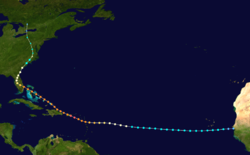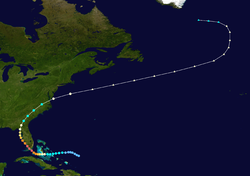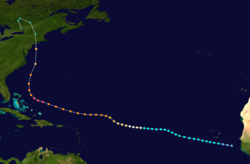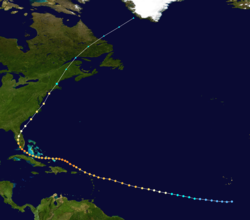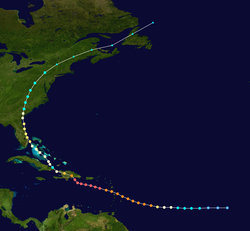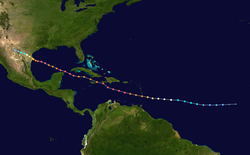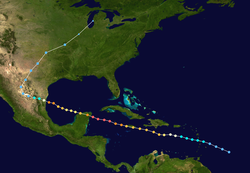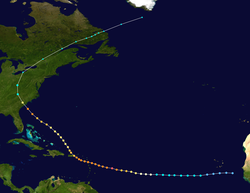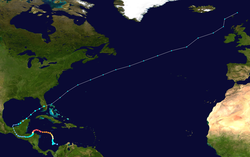Top Qs
Timeline
Chat
Perspective
Talk:List of Category 5 Atlantic hurricanes/old version
From Wikipedia, the free encyclopedia
Remove ads
A Category 5 hurricane (the highest category on the Saffir-Simpson Hurricane Scale) has sustained winds higher than 155 mph (250 km/h). A hurricane (tropical cyclone) of this intensity is rare in the Atlantic Ocean, occurring about once every three years on average — though four occurred in 2005, the most ever in one season. Only three seasons (1960, 1961 and 2005) have had multiple Category 5 hurricanes in the Atlantic basin, which includes the North Atlantic, the Caribbean Sea, and the Gulf of Mexico.
Remove ads
Statistics
Between 1851 and 2005, twenty-nine hurricanes are estimated by the NHC to have had Category 5 sustained winds, none of which occurred before 1928. It is certain that some earlier storms reached Category 5, but the lack of reliable measurements makes reasonable estimations impossible. Note that re-analysis is ongoing and this list may change as more accurate estimations of older hurricanes become available.
In the Atlantic basin, 11 hurricanes have made landfall at Category 5 intensity. Only three — the Labor Day Hurricane (1935), Hurricane Camille (1969), and Hurricane Andrew (1992) — made landfall in the United States at Category 5. Andrew and Hurricane Camille were the only hurricanes to make landfall twice at Category 5.
Three other Category 5 hurricanes (Dog, Easy and Cleo) never made landfall at any intensity.
Remove ads
List of Category 5 Atlantic hurricanes
Summarize
Perspective
In chronological order from earliest to most recent. Names in quotes are unofficial. A blank indicates hurricane did not make landfall at Category 5 intensity.
- Date Attained is the date when the storm first achieved Category 5 status. (Several of these storms reached Category 5 more than once)
- Landfall is the place the storm struck land at Category 5 status. (Note that the storm may have affected other land masses at a different category.)
- † Pressure readings for older storms are reliable but incomplete, especially for storms that did not threaten land. The listed pressure is likely not the lowest pressure achieved by the hurricane.
- ‡ Wind speed data for storms prior to 1997 are not reliable because surface wind speed was rarely measured before dropsondes came into use. Some speed values may have been updated after re-analysis in the late 1990s.
- ¹ A pressure reading (later determined by the weather service to be accurate) was taken by a weather observer on the ground as the eye passed over Long Key, Florida.
Remove ads
See also
External links
Wikiwand - on
Seamless Wikipedia browsing. On steroids.
Remove ads
